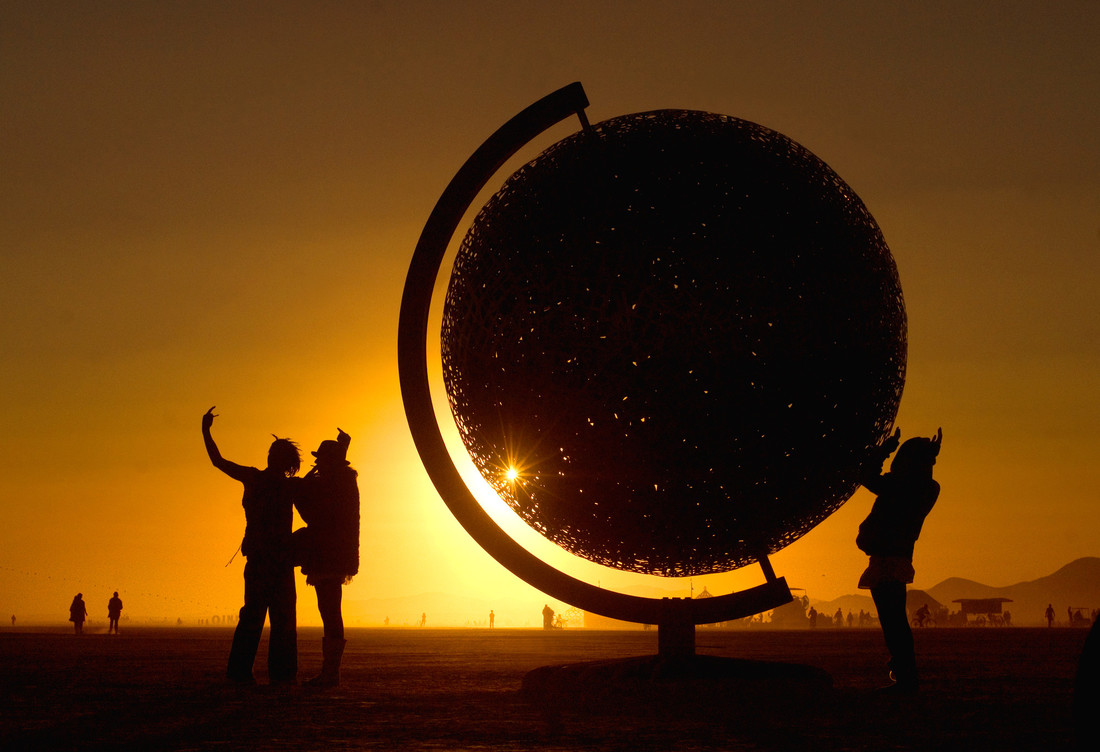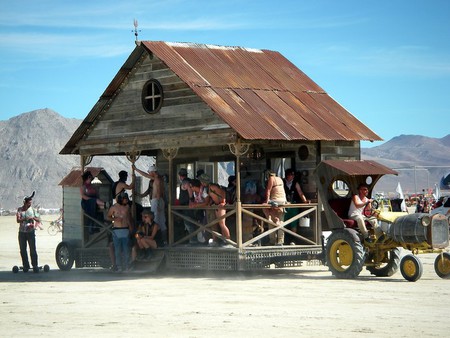
- Red and Blue neon head
- Red and Green Neon body with blue details at the clavicle, ornament, hands and feet.
- The Neon Team added a subtle black stripe to several of the tubes, thus giving it a stronger sense of dimensionality than usual.
- Pavilion with double staircase and gargoyles
- Surrounding the Man was Polygonia – close to 2,000 puzzle-type pieces approximately three feet in diameter. Hundreds of people enjoyed building small towers, chairs, structures to help shade them from the sun, and more.
- "Metropolights", created by Jack Haye, Mike Hollibaugh, Julie Young, and Claus Brigmann, surrounded the Man base.


Burning Man introduces the Metropol Blog Series of writings related to Black Rock City
Metropol will tell the story of how a very unorthodox camping trip managed to morph, over the course of 20 years, into a 5 square-mile metropolis. An introductory essay by Rod Garrett, Designing Black Rock City, will provide us with a very useful guide to understanding our city’s history.
In this spirit, we invite our city’s citizens to join in this discussion. If Black Rock City is a hive, it’s always been participants who make its honey. Tell us about the life on our streets as you have experienced it. What does it really take to make a neighborhood? How can the needs and aspirations of community be served by civic planning? How might we perfect our urban model, and what are you willing to contribute toward making this happen? – Larry Harvey


In 2009, The Electronic Frontier Foundation posted a criticism of Burning Man's Terms and Conditions regarding Burning Man's Terms of Use" Andie Grace posted a blog in answer "Snatching Digital Rights" or Protecting Our Culture? Burning Man and the EFF and in 2010 a Blog series on Digital Rights was started to continue to dialogue with photographers, theme camps, artists, interested participant groups, Creative Commons and the Electric Frontier Foundation (EFF) in order to improve our policies for the present and for the future. We will be talking (if not facilitating public discussions) about this process at the Burning Man event.
This resulted in a re-crafting of BurningMan use policies with the help of the Electronic Frontier Foundation and Creative Commons, advised by an intense feedback period with our blog readers and Jack Rabbit Speaks subscribers, several discussion sessions and a photographer’s salon around the cultural implications of image policy evolution, the creation of a Trademarks and Image Use Guidelines page to better illustrate our community practices and help participants avoid pitfalls in their use of marks and images and the presentation of this evolution of Burning Man policies and practices at Austin’s South By Southwest Interactive Festival, the Open Video Conference in New York City, and in several other public forums.
Read moreIn 2010, Burning Man embraced Black Rock City’s place in the world as a fully-functioning temporary city, one that not only acts as a living model for the dynamics of urban planning, but also as the ultimate Petri dish for experiments in the possibilities of large-scale human collaboration.
Larry Harvey’s 2010 art theme “Metropolis: The Life of Cities”, asked participants to contemplate the impact of urban planning and design on community and culture, and to consider how interpersonal interactions fostered by a closely-connected urban environment affect synergistic collaborative potential. There are few – if any – other places on the planet where these are more vividly on display than at Burning Man, earning Black Rock City its standing as one of the great cities of the world.
By mid-afternoon on opening day of Burning Man 2010, as the citizens of Black Rock City watched the skies darken with stormclouds rolling in over the playa, the skies opened up, deluging the city with a powerful three-hour rainstorm. Black Rock City quickly became a giant mudslick, and the Playa Operations Team put out the call (via staff radios and Burning Man Information Radio) to temporarily suspend all vehicular traffic.
At its peak, Black Rock City 2010 had a record population of 51,525 participants – so many that two concentric streets (London and Mumbai) were added to the city mid-week – and yet still, the city felt like a cohesive community. Of the 275 registered art projects on playa, 36 were honoraria projects funded by the Burning Man art grants program. Iconic amongst the art was Marco Cochrane’s (self-funded) 40′-tall steel female figure “Bliss Dance”, “Infinitarium” by Karen Cusolito and Big Art Studios, Kate Raudenbush’s “Futures Past”, and Bryan Tedrick’s “Minaret” keyhole piece.
Read more
Jordan Romney 2010 footage

Burning Man 2010: Metropolis event ticket designed by Arin Fishskin http://arinfishkin.com
- Following a down-year as a result of the global economic crisis, Black Rock City resumed its usual uptick in population, seeing the largest number of participants to date.
- There were 275 registered art projects on playa, including 36 honoraria projects that were funded by the Burning Man art grants program.
- The Flux Foundation arts collective, headed by Jessica Hobbs, Rebecca Anders and Peter "PK" Kimmelman, created the Temple of Flux, resembling massive canyon structures reminiscent of the canyonlands of southern Utah. This was the first time a non-traditional temple design was used for Burning Man's Temple, which was ceremoniously burned on Sunday night.
- Black Rock City was deluged by a 3-hour rainstorm on Monday of the event, turning the entire event site into a mudslick, and forcing the closure of all roads to vehicular traffic for several hours, and doing damage to camps and technological systems across the playa.
- The citizens of Black Rock City were delighted by the appearance of an incredibly vivid double rainbow, prompting many to wonder aloud: "What does it mean?"
- City streets were named after some of the world's major metropolises and megatropolises, from Athens to Kyoto.
- City blocks were slightly deeper, and three public plazas were created at 3:00, 6:00 and 9:00 at Jakarta Street, as a Metropolis-theme experiment in spontaneous urban planning and collaboration.
- To accommodate the anticipated increase in population, two concentric streets (London and Mumbai) were added to the back of the city mid-event, stretching from the 10:00 to the 6:00 radial streets.
- The Center Camp circle included one (rather than two, as it was in 2009) service road, called "Route 66".
- About 700 registered theme camps were pre-placed; of these, 626 were theme camps, 39 were villages, and 35 were other camps (art support camps, for example). About 30 camps were declined pre-placement.
- The DMV saw a continued increase in mutant vehicle applicants, and for the first time received more than 1,000 applications.
- The Yellow Bike Program, providing shared community bikes, returned for its fifth year, and was more successful than ever.
- The Black Rock Arts Foundation, Black Rock Solar, Burners Without Borders and the Burning Man Regional Network joined forces to create the "District Everywhere" public theme camp on the Esplanade next to Center Camp, inviting participants to learn about their year-round efforts to spread Burning Man culture.
- Burning Man hosted its first official gathering for academics, inviting those studying or researching around Burning Man and Black Rock City together for a playa meet and greet. The invitation was met with overwhelming response and nearly 200 respondents RSVP'd for the event, held on Thursday at the Ashram Galactica.
- Burners' herculean Leave No Trace efforts resulted in the cleanest Black Rock City yet, as reflected in the now-annual MOOP Map.
- For the first time ever, the playa clean-up effort was halted by heavy rains, forcing the Playa Restoration crew to wade (and slog) shin-deep in the resulting Lake Lahontan to remove the final detritus from the event site.
- The BLM's annual post-event site inspection was postponed until spring due to the flooded playa.
- The worldwide network of Regional Contacts expanded to welcome 27 new representatives - accommodating not only turnover in existing regions, but adding new locations around the world, including the Philippines; Perth, Sydney, and Melbourne Australia; and new domestic outposts in Bellingham, Washington and Nebraska.
- Burning Man hosted the fourth annual Regional Leadership Summit at San Francisco's Bently Reserve, which brought together Regional Contacts and other prominent leaders to share ideas and information about spreading Burning Man culture year-round; it included a Convectional Caucus, an information-sharing showcase for Burning Man groups and departments.
- Burning Man invited 12 regional leaders, representing various geographic areas and ranges of expertise, to form a Meta-Regional Committee, supporting the leadership and governance of the Regional Network.
- After the The Electronic Frontier Foundation (EFF) published a sharp critique of Burning Man's terms and conditions regarding photographers' rights, Burning Man hosted open meetings and panel discussions at Burning Man HQ, on playa, at the SXSWi conference, and on the Burning Blog to help determine where best to draw the line between photographers' rights and protecting Burning Man culture from exploitation.
- In the spirit of the Metropolis art theme, the "Metropol" blog series in the Burning Blog presented a variety of articles about the impact of urban planning and design on culture and community, particularly with regard to Black Rock City as an experimental sandbox.
- The Burning Man image galleries were overhauled with brand new technology, making image upload significantly easier for photographers, as well as including video archives.
- The Burning Man Board continued its search for new office space for Burning Man's headquarters that could also accommodate the creation of a fully-realized "urban center", including public space reflecting the communal values of Burning Man, as well as private space for management operations. The search focused primarily on San Francisco's mid-Market neighborhood.
- The Burning Man website was updated to reflect Burning Man's new organizational structure.

Southpark: "Coon vs. Coon and Friends" Season 14, Episode 13, aired November 10, 2010
Cartman and Cthulhu attack Burning Man, that is, according to Cartman, "the biggest hippie festival in the world"










































